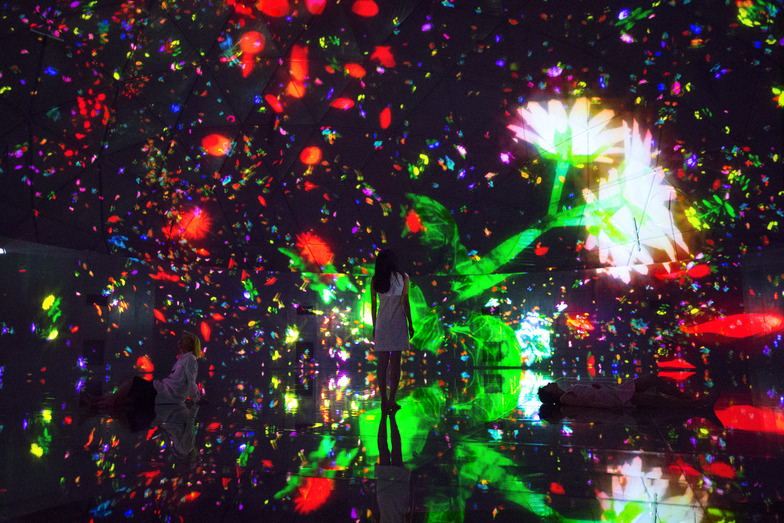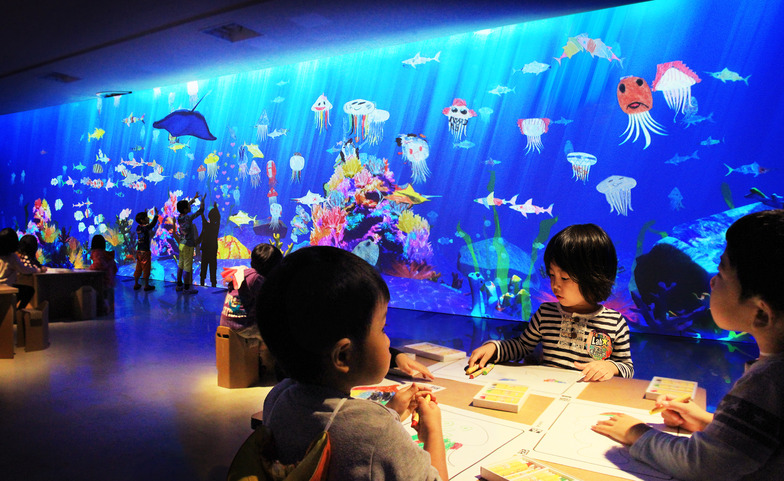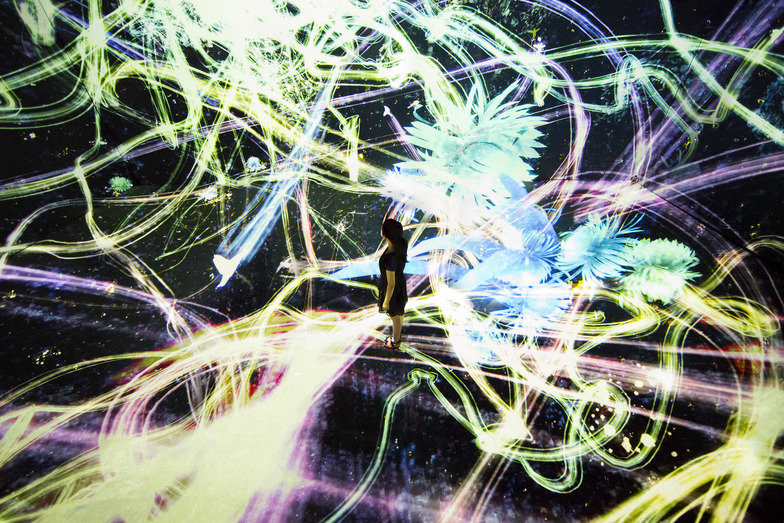Note: This website was automatically translated, so some terms or nuances may not be completely accurate.
The Grand Experiment of Expanding Art Liberating People and Society: The Path Forward ~ Toshiyuki Inoko, CEO of teamLab ~

Toshiyuki Inoko
TeamLab
TeamLab, led by Toshiyuki Inoko, is gaining attention for its cutting-edge activities in digital art. Its 2015 exhibition "Dancing! Art Exhibition and Learning! Future Amusement Park" recorded the third-highest attendance among art exhibitions in Japan that year, following the Monet exhibition and the Louvre exhibition. TeamLab has also held large-scale exhibitions worldwide, including in New York, London, and Paris. The large-scale exhibition "teamLab: Living Digital Space and Future Parks," currently running in Silicon Valley, has drawn such record-breaking crowds since its February 2016 opening—with long lines forming every weekend—that its scheduled July closing date was extended to December. Furthermore, a permanent exhibition opened at Marina Bay Sands in Singapore in March, and starting in August, the world's second permanent exhibition opened at Lotte World in Seoul. Its reputation has now spread to a global level. What exactly is the goal of this "ultra-technologist collective," who are both engineers and artists, creating digital art that vastly exceeds the conventional norms of art? We asked Inoko about it.
(Interviewer: Yuzo Ono, Director, Digital Platform Center, Dentsu Digital Inc.)

Hints for a New Digital Society Lie in "Discarded Culture"
──Your comment in this year's Jakuchu exhibition catalog was striking: "Throughout history, much of the cultural knowledge humanity cultivated over centuries was discarded because it didn't fit with modern society. And within those discarded things, might we find hints for this new society, different from the modern one?" It seems your activities connect these "discarded things" to cutting-edge digital technology.
Inoko: Yes, I believe that within these "discarded things," there may lie hints for a new society.
We humans constantly live amidst major shifts in values. When significant social changes or revolutions occur, almost everything that was once important becomes unimportant, while things previously deemed unimportant suddenly become vital. For example, in ancient times, people who could throw stones far and accurately or who were fast runners were great, but at some point, those possessing farming skills became more important. Or, after the Meiji Restoration, the chonmage hairstyle, which had previously been considered cool, suddenly took on a negative image.
Similarly, a moment is approaching when things we currently value will cease to matter. In such times, the cultures discarded throughout human history become our anchor. I believe hints for navigating this new society are hidden within the pre-modern cultures and values that have been discarded until now.
When we plunged into modern society, much "cultural knowledge" vanished because it didn't fit with modernity. I'm fundamentally curious about how people before modernity perceived and understood the world, what values they lived by. But beyond that, I suspect that hints for building a new society might actually lie within these lost things, rather than within the knowledge modernity deemed important.
The modern era, meaning the 20th century, was a society where information was obtained from things not directly related to oneself: reading books, watching TV, being influenced by ads, listening to the radio, reading newspapers. But with digitalization and social media, if society is shifting toward obtaining information from things deeply connected to oneself, this might actually be closer to how information was obtained before modernity. In that sense, pre-modern societies, which obtained information from interrelated sources, likely held different values than the 20th century. If so, might those pre-modern values and behaviors become important for the times ahead?
We are in a transitional period. Many aspects of the 20th century remain, and adults reflexively assume everything that was important then remains important now. But to live in this new society, we must consciously reject what was valued in the 20th century. Conversely, understanding pre-modern times can provide clues.
──When considering this pre-modern era, you yourself have long focused on Jakuchu.
Inoko: Jakuchu was one of Japan's top five most popular painters during the mid-Edo period. He was a true superstar. Yet in the modern era after the Industrial Revolution, he became completely unknown. The moment we entered the information society centered around the internet, he suddenly became popular again, this time becoming the artist with the greatest drawing power in Japanese art history. I think he's a symbolic figure suggesting that hints for a new society lie in the pre-modern era.
Also, I'm fascinated by paintings themselves. Unlike books written or edited by people influenced by modern perspectives and ways of thinking about the pre-modern era, paintings preserve the world as it was seen back then. That's why I love paintings.
──What do you find particularly fascinating about Jakuchu?
Inoko: The 20th-century perspective was one where the self and the world being observed were separated, much like Western perspective or photography. We've "observed" the world as if looking through a camera lens.
Paintings and photographs project a three-dimensional world—or even a four-dimensional world if you include time—onto a two-dimensional plane. I don't think Jakuchu painted something unusual out of individuality. He kept chickens at home to paint them accurately. I believe his paintings emerged from his pursuit of faithful realism. That suggests his spatial perception was fundamentally different.
The world "people like Jakuchu might have seen" and the digital art world we at teamLab are trying to create are probably somewhat similar. We call the world we aim for "Hyper-Subjective Space." There, multiple people share the same space, each recognizing the world while moving freely in all directions without fixing their viewpoint. By leveraging the characteristics of hyper-subjective space, we believe we can create a world where people understand they share a space with others, yet simultaneously recognize themselves as the protagonist, allowing everyone present to act freely. We think creating such a world could present humanity with a new relationship between society and individuals.
The "art museum," where one behaves independently of others, is a symbol of modern society.
──TeamLab's works often feature interactivity, like when viewers touch an installation and text appears, changing the work's content through their actions.
Inoko: For example, when you go to see the "Mona Lisa" at an art exhibition, it's crowded, and others are seen as annoying and bothersome. But that's because the Mona Lisa doesn't change due to the presence of others. So others are just a nuisance. If, however, the Mona Lisa changed due to the presence of others, and that change itself were beautiful, then the presence of others wouldn't be a nuisance. In a world where the presence of others makes things beautiful, the presence of others becomes positive.
And the same applies to so-called modern cities. In highly developed modern cities, people have acted as if their existence were completely unrelated to others, lacking any sense of influencing their surroundings or society. Under the premise that others are nuisances, an unnecessary multitude of manners and rules have been created.
──I see. So, one symbolic embodiment of this modern urban mindset is the art museum or art exhibition, you're saying.
Inoko: But what if we had a society like pre-modern Japan, like terraced rice fields, where people mutually influenced each other? Terraced fields have elevation differences, creating a system where water constantly flows from one field to the next. Because the water keeps flowing, it doesn't stagnate. Your own field exists because the neighboring field is there. In a world where your actions directly affect your neighbor's, and vice versa, many things would change. What exists there is a world where you and others coexist, each influencing the other to transform beautifully. If digital art envelops the city, and if we can intuitively, physically understand that, then the presence and actions of others could potentially transform the city into a positive place.
Thinking about this, we create works that overlap digital art with the modern city. With digital evolution, art has been liberated from physical materials like canvas, existing in a state where only expression can freely transform. As a result, it's now possible to directly expand spaces like streets into art or interactively alter them. Through our activities, we'd be delighted if we could help create a world where the presence of others feels positive once again.
──TeamLab has held many exhibitions of digital art, like "TeamLab: DANCE! ART EXHIBITION and LEARN! FUTURE PLAYGROUND," where the art changes as people touch and interact with it. These are precisely the kind of experiences that make the presence of others feel positive, right?
Inoko: Despite the high crowd density at our exhibitions, visitors move freely and unrestrained. Children especially have a blast running, dancing, and touching the artworks. You won't find art exhibitions like that anywhere else (laughs).
At our exhibitions, even with more people than usual, the crowd doesn't feel overwhelming. That's because people unconsciously perceive others positively. We constantly strive to create art that transforms the relationships between people within that space. While we can only create limited spaces now, I believe that if the world were someday filled with art like ours, it could foster a society where people are unconsciously positive toward others. Even if we can't fully understand or control it, we hope that naturally affirming others could lead to greater freedom for everyone.
──So by using digital technology to find clues within what modern society has "discarded," we can realize a new, freer society.
Inoko: Highly developed society has fixed people in place, turning them into sheep raised in a factory. Someday, I want to use the power of digital art to free people once more and create a society where acting freely doesn't evoke disgust. It's a grand experiment: using art's power to liberate people—like how an artwork changes through others' actions—and thereby create a new world free from modernist thought. Of course, we can't just build cities however we want, so we're conducting this experiment at exhibitions (laughs).
Artificial intelligence that cannot "persuade" with new beauty will never surpass human creativity.
──Artificial intelligence (AI) has been a hot topic lately. How do you personally view AI?
Inoko: In a society where AI has advanced, most jobs will likely be automated. The only thing that survives in that world is creativity. And since humans are creatures that create collectively, at teamLab we use the term "co-creation." Going forward, only such collaborative creation will constitute work. In that sense, in a society where artificial intelligence advances, only so-called creativity will be valued, and past answers will hold no added value. That's something we can leave to artificial intelligence.
──Criticism persists that the advancement of artificial intelligence poses a threat to humanity's future.
Inoko: I believe we should stop anything that exceeds the scope of human control. It's possible that humanity itself may have to halt AI development.
──Current AI is already beginning to create music and novels. Couldn't AI eventually take on the role of creativity?
Inoko: AI might indeed be able to paint like Van Gogh. But that isn't art. Art, ultimately, is about making people perceive concepts previously excluded from beauty as beautiful. This new beauty isn't some logical correct answer. And even if AI creates something similar, the viewer won't perceive it that way. Humans are persuaded by other humans with physical bodies. For example, TeamLab believes that art is making humanity feel that changing the relationships in a space is a new kind of beauty, and that is something only humans can do.
Works where viewers and elements within the piece influence each other and change in real time never return to the same state twice. ( Images and videos of teamLab works : http://www.team-lab.netでご覧いただけます )





Was this article helpful?
Newsletter registration is here
We select and publish important news every day
For inquiries about this article
Author

Toshiyuki Inoko
TeamLab
Representative/Digital Art Creator
Born in Tokushima City in 1977. Founded teamLab immediately upon graduating from the Department of Applied Mathematics and Systems Engineering, Faculty of Engineering, University of Tokyo in 2001. teamLab is an ultra-technologist collective composed of specialists from various fields of the digital society, including programmers, engineers, CG animators, illustrators, mathematicians, architects, web designers, graphic designers, and editors. It operates while blurring the boundaries between art, science, technology, and creativity. ( <a href="http://www.team-lab.net/" target="_blank">http://www.team-lab.net/</a> )